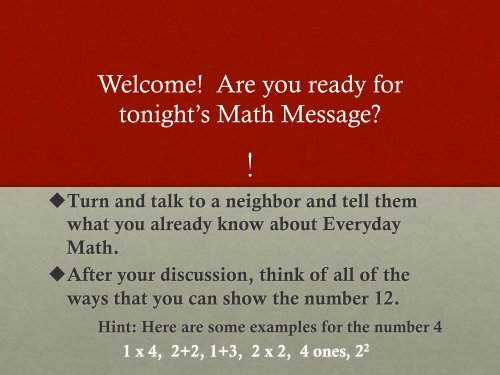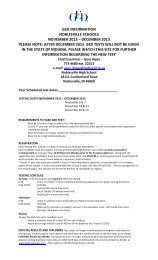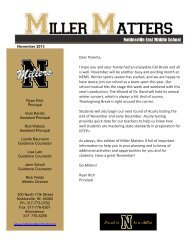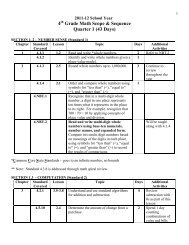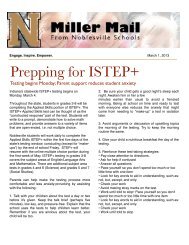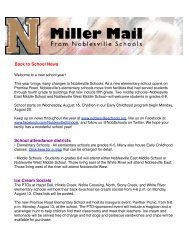Everyday Math PDF 3-5 - Noblesville Schools
Everyday Math PDF 3-5 - Noblesville Schools
Everyday Math PDF 3-5 - Noblesville Schools
You also want an ePaper? Increase the reach of your titles
YUMPU automatically turns print PDFs into web optimized ePapers that Google loves.
Welcome! Are you ready for<br />
tonight’s <strong>Math</strong> Message?<br />
u Turn and talk to a neighbor and tell them<br />
what you already know about <strong>Everyday</strong><br />
<strong>Math</strong>.<br />
u After your discussion, think of all of the<br />
ways that you can show the number 12.<br />
!<br />
Hint: Here are some examples for the number 4<br />
1 x 4, 2+2, 1+3, 2 x 2, 4 ones, 22
Welcome Parents!<br />
<strong>Everyday</strong> <strong>Math</strong> Information Night<br />
White River Elementary School
Curriculum Features<br />
• Real-life problem solving<br />
• Balanced instruction<br />
• Multiple methods for basic skills practice<br />
• Emphasis on communication of mathematic thinking<br />
• Deep in common core standards<br />
• Spiraling curriculum
A Spiraling Curriculum<br />
• Mastery of mathematics concepts and skills<br />
comes with repeated exposure and practice, not<br />
after just one lesson<br />
• Concepts are consistently reviewed throughout<br />
the model<br />
• Skills are identified as beginning, developing,<br />
and secure as the spiral progresses<br />
• The spiral may take 2 to 3 years for mastery to<br />
be achieved
Daily Lesson Format<br />
1. Warm-up activities<br />
2. Introduction of new content<br />
3. Ongoing review and practice<br />
4. Games<br />
5. Home/Study Links (Homework)
Warm-Up Activities<br />
• Mental <strong>Math</strong> and Reflexes- Brief exercises, usually<br />
oral, designed to strengthen children’s number sense<br />
and to review and advance essential basic skills.<br />
• <strong>Math</strong> Message- A short oral problem that sets the tone<br />
and focus for the content of the lesson.
Daily Lesson Format<br />
1. Warm-up activities<br />
2. Introduction of new content<br />
3. Ongoing review and practice<br />
4. Games<br />
5. Home/Study Links (Homework)
Introduction of<br />
New Content<br />
• New concepts are introduced through explorations<br />
and problem-solving opportunities.<br />
• <strong>Math</strong> Journal Pages reinforce the concepts being<br />
taught for a particular lesson.
Daily Lesson Format<br />
1. Warm-up activities<br />
2. Introduction of new content<br />
3. Ongoing review and practice<br />
4. Games<br />
5. Home/Study Links (Homework)
Ongoing Learning &<br />
Practice<br />
• <strong>Math</strong> Boxes review and preview mathematical content<br />
by providing continuous practice of all skills and<br />
concepts in <strong>Everyday</strong> <strong>Math</strong>. (Spiraling!)<br />
• <strong>Math</strong> boxes are designed as independent practice.
Daily Lesson Format<br />
1. Warm-up activities<br />
2. Introduction of new content<br />
3. Ongoing learning and practice<br />
4. <strong>Math</strong> Games<br />
5. Home/Study Links (Homework)
<strong>Math</strong> Games<br />
Games provide necessary practice for children to build,<br />
master, and maintain strong mental arithmetic skills.<br />
There is typically a game with every lesson.<br />
Top-it is a game that is played at most grade levels. We<br />
look forward to sharing the game with you tonight so<br />
that you can play at home!
Daily Lesson Format<br />
1. Warm-up activities<br />
2. Introduction of new content<br />
3. Ongoing learning and practice<br />
4. <strong>Math</strong> Games<br />
5. Home/Study Links (Homework)
Home Links<br />
Study Links<br />
• Homework will say “Home Link” or “Study Link” on<br />
the top.<br />
• It is important for your child to bring their Home/<br />
Study Links back to school.<br />
• Authors encourage family support for Home/Study<br />
Link completion. This is your opportunity to become<br />
involved in your child’s math education!<br />
• Parent information is provided in the Family Letter<br />
that comes home with each new unit
Family Letter<br />
• When each unit begins, a parent information letter is<br />
sent home explaining math ideas for the unit.<br />
• Shhh! It has all homework answers for the unit!<br />
• KEEP THIS LETTER IN A SAFE PLACE!
What Parents Can<br />
Do to Help<br />
• Read the Family letters – use the answer key to<br />
help your child with their homework.<br />
• Ask your child to teach you the math games<br />
and play them.<br />
• Help your child memorize math facts.<br />
• Contact your child’s teacher<br />
with questions or concerns.<br />
• Ask your child to teach you<br />
the new algorithms.
More Questions?<br />
• If you have further questions, please write<br />
them on a sticky note and place them on the<br />
easel. We will respond to frequently asked<br />
questions in newsletters in the near future!
Addition Top-It<br />
• Materials: A deck of cards with face cards removed.<br />
1. Shuffle the cards and place them in a pile facedown between two<br />
players.<br />
2. One player turns over two cards and says the sum of the numbers.<br />
3. The other player turns over the next two cards and says the sum<br />
of the numbers.<br />
4. The player with the higher sum takes all four cards.<br />
5. In case of a tie, each player draws two more cards to find a new<br />
sum. The higher sum wins all 8 cards.<br />
6. The winner is the player with the most cards when there are not<br />
enough cards left for another turn.
Thank you for<br />
coming!


